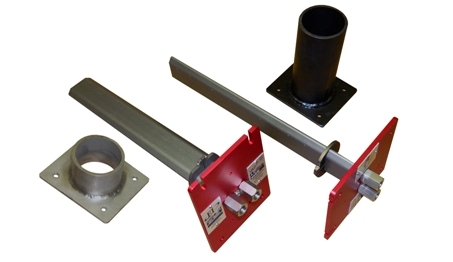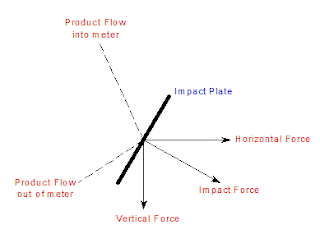Air Flow Measurement Accuracy within a Particulate Laden Air Stream
Measuring the Air Flow in a duct can be difficult enough when the flow profile is not free from turbulence, disturbances, cyclonic flow, and reverse flow, but add to that particulate, ash, dust, or debris in the air, and it can almost be impossible. So, how do you get accuracy when trying to measure the Air Flow in a duct that has particulate, ash, dust, or debris in the air stream?
The traditional way is to use a blast purge or blow back system that will take high pressure compressed air and blow it back through the high and low ports of the air flow pitot or flow element so that any particles, ash, dust, or debris is blown out of the ports on the probe. This not only uses a lot of compressed air, which needs to be completely dry to work properly, but it also requires a complex system of valves in order for this to be done automatically. If the blast purge or blow back is not done on a regular basis, and if the particulate, ash, dust, or debris level is high enough in the duct, the pitot or air flow element or probe will plug very quickly causing the measurement to be inaccurate. An automatic system is needed to perform this purge or blow out while the system is being used to measure the flow of the air in the duct. This adds another level of complexity since the differential pressure transmitter or multivariable transmitter signal would need to be locked out or isolated while the purge or blow out is being performed so that the system does not think that the result of sending the high pressure compressed air through the pitot or flow element is changing or so that the transmitter does not get damaged from over pressurization. As you can see this can be a very difficult thing to do and makes the cost of measurement of an air stream with particulate much more expensive.
THE VAP³ PITOT
A better way to deal with this would be to use a pitot or flow element or probe that is plug resistant, not allowing the particulate, ash, dust, or debris from plugging the ports on the probe. The VAP³ Pitot is a perfect solution to this issue. The VAP³ probe can be configured in what is called the PA mode, thus orienting the probe so that the probe becomes resistant to plugging.
So, how does this work? With the probe in the PA orientation, the High Port, which is typically on the upstream end of the probe, is located on the back side or downstream end. Having the High Port on the back side prevents the particulate, ash, dust, or debris from impacting the port, plugging it and causing the differential pressure measurement to be altered, thus making the air flow measurement inaccurate. This patented design can be used from 1,500 ft/min to 12,500 ft/min air flow velocities, making it perfect for most duct configurations.
The VAP³ Pitots are an Insertion Probe style or Direct Duct Mount style using the included Insertion Ports that would be welded or connected directly to any existing ductwork. The probes are manufactured from 6061 Aluminum (Hard Coat Anodized) or 301 Stainless Steel, and are sized to fit the duct dimensions. An array of probes is recommended based on the duct configuration or size to obtain the highest degree of air flow measurement accuracy.
For more information on the VAP³ Pitots, DSV Flow Elements, or High Beta Flow Elements, click one of links or visit our website at easterninstruments.com, or call us at 910-392-2490, or email at sales@easterninstruments.com.
The traditional way is to use a blast purge or blow back system that will take high pressure compressed air and blow it back through the high and low ports of the air flow pitot or flow element so that any particles, ash, dust, or debris is blown out of the ports on the probe. This not only uses a lot of compressed air, which needs to be completely dry to work properly, but it also requires a complex system of valves in order for this to be done automatically. If the blast purge or blow back is not done on a regular basis, and if the particulate, ash, dust, or debris level is high enough in the duct, the pitot or air flow element or probe will plug very quickly causing the measurement to be inaccurate. An automatic system is needed to perform this purge or blow out while the system is being used to measure the flow of the air in the duct. This adds another level of complexity since the differential pressure transmitter or multivariable transmitter signal would need to be locked out or isolated while the purge or blow out is being performed so that the system does not think that the result of sending the high pressure compressed air through the pitot or flow element is changing or so that the transmitter does not get damaged from over pressurization. As you can see this can be a very difficult thing to do and makes the cost of measurement of an air stream with particulate much more expensive.
THE VAP³ PITOT
A better way to deal with this would be to use a pitot or flow element or probe that is plug resistant, not allowing the particulate, ash, dust, or debris from plugging the ports on the probe. The VAP³ Pitot is a perfect solution to this issue. The VAP³ probe can be configured in what is called the PA mode, thus orienting the probe so that the probe becomes resistant to plugging.
 |
| VAP³ PA Pitot from Eastern Instruments |
The VAP³ Pitots are an Insertion Probe style or Direct Duct Mount style using the included Insertion Ports that would be welded or connected directly to any existing ductwork. The probes are manufactured from 6061 Aluminum (Hard Coat Anodized) or 301 Stainless Steel, and are sized to fit the duct dimensions. An array of probes is recommended based on the duct configuration or size to obtain the highest degree of air flow measurement accuracy.
For more information on the VAP³ Pitots, DSV Flow Elements, or High Beta Flow Elements, click one of links or visit our website at easterninstruments.com, or call us at 910-392-2490, or email at sales@easterninstruments.com.


